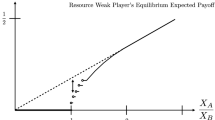Abstract
Game theory has provided many tools for the study of social conflict. The 2 × 2 game has been found to be a particularly useful model. This paper describes the enumeration and analysis of all 726 distinct 2 × 2 games. A computer is used to generate the complete set, and a wide variety of maximin, equilibrium and stability calculations is performed for each player for every outcome in every game. The resulting data set is of great value for both the modeling and analysis of social conflict.
Similar content being viewed by others
Bibliography
Axelrod, R.: 1984,The Evolution of Cooperation, Basic Books, New York.
Basar, T. and Olsder, G. J.: 1982,Dynamic Non-Cooperative Game Theory, Academic Press, New York.
Brams, S. J.: 1985,Superpower Games: Applying Game Theory to Superpower Conflicts, Yale University Press, New Haven, Connecticut.
Brams, S. J.: 1977, ‘Deception in 2 × 2 Games’,Journal of Peace Science 2, 171–203.
Brams, S. J. and Davis, M. D.: 1983, ‘The Verification Problem in Arms Control: a Game Theoretic Analysis’, Presentation to the Joint National Meeting of the Operations Research Society of America and the Institute of Management Sciences, Orlando, Florida, Nov. 7–9, 1983.
Brams, S. J. and Wittman, D.: 1981, ‘Non-Myopic Equilibrium in 2 × 2 Games’,Conflict Management and Peace Science 6, 39–62.
Fraser, N. M. and Hipel, K. W.: 1979, ‘Solving Complex Conflicts’,IEEE Transactions on Systems, Man and Cybernetics SMC-9, 181–185.
Fraser, N. M. and Hipel, K. W.: 1984,Conflict Analysis: Models and Resolutions, North-Holland, New York.
Guyer, M. and Hamburger, H.: 1968, ‘A Note on a “Taxonomy of 2 × 2 Games”’,General Systems 13, 205–208.
Henderson, J. M. and Quandt, R. E.: 1971,Microeconomic Theory: A Mathematical Approach, 2nd ed., McGraw-Hill, New York.
Howard, N.: 1971,Paradoxes of Rationality, The MIT Press, Cambridge, Mass.
Kalevar, C. K.: 1975, ‘Metagame Taxonomies of 2 × 2 Games’,General Systems 20.
Kilgour, D. M.: 1984, ‘Equilibria for Far-sighted Players’,Theory and Decision 16, 135–157.
Kilgour, D. M.: 1985, ‘Anticipation and Stability in Two-person Non-cooperative Games’, in M. D. Ward and U. Luterbacher, (eds.),Dynamic Models of International Conflict, Lynne Rienner, Boulder, Colorado.
Kilgour, D. M., Hipel, K. W. and Fraser, N. M.: 1984, ‘Solution Concepts in Non-cooperative Games’,Large Scale Systems 6, 49–72.
Nash, J. F.: 1951, ‘Non-Cooperative Games’,Annals of Mathematics 54, 286–295.
Rapoport, A.: 1967, ‘Escape from Paradox’,Scientific American, July, 50–56.
Rapoport, A. and Chammah, A. M.: 1965,Prisoner's Dilemma. University of Michigan Press, Ann Arbor.
Rapoport, A. and Chammah, A. M.: 1966, ‘The Game of Chicken’,American Behavioral Scientist 10, 23–28.
Rapoport, A. and Guyer, M. J.: 1966, ‘A Taxonomy of 2 × 2 Games’,General Systems 11, 203–214.
Rapoport, A., Guyer, M. J. and Gordon, D. G.: 1976,The 2 × 2 Game, The University of Michigan Press, Ann Arbor.
Snyder, G. H.: 1971 ‘Prisoner's Dilemma and Chicken Models in International Politics’,International Studies Quarterly 15, 97.
Snyder, G. H. and Diesing, P.: 1977,Conflict Among Nations, Princeton University Press, Princeton, N.J.
Von Neumann, J. and Morgenstern, O.: 1953,Theory of Games and Economic Behavior, 3rd Edition, Princeton University Press, Princeton, N.J.
Zagare, F. C.: 1981, ‘Non-myopic Equilibria and the Middle East Crisis of 1967’,Conflict Management and Peace Science 5, 139–162.
Zagare, F. C.: 1984, ‘Limited Move Equilibria in 2 × 2 Games’,Theory and Decision 16, 1–19.
Zagare, F. C.: 1985, ‘The Pathology of Unilateral Deterrence’, in M. D. Ward and U. Luterbacher (eds.),Dynamic Models of International Conflict, Lynne Rienner, Boulder, Colorado.
Author information
Authors and Affiliations
Rights and permissions
About this article
Cite this article
Fraser, N.M., Kilgour, D.M. Non-strict ordinal 2 × 2 games: A comprehensive computer-assisted analysis of the 726 possibilities. Theor Decis 20, 99–121 (1986). https://doi.org/10.1007/BF00135087
Issue Date:
DOI: https://doi.org/10.1007/BF00135087




